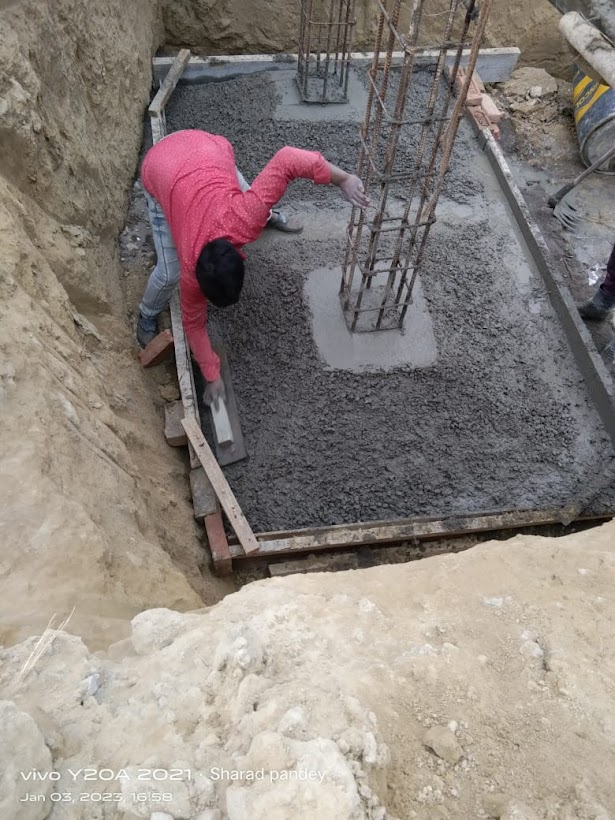Types of Foundation Used in Construction
There are various types of foundations used in construction, depending on the soil conditions, load-bearing capacity, and other factors. Some common types of foundations are:
Strip Foundation: This type of foundation is used for low-rise buildings where the load is spread over a wide area. It consists of a continuous strip of concrete or masonry that runs along the perimeter of the building.
Raft Foundation: This type of foundation is used for large or heavy structures where the load is spread over a wide area. It consists of a concrete slab that covers the entire area of the building, with reinforced concrete beams to support the load.
Pile Foundation: This type of foundation is used in areas where the soil is weak or unstable. It consists of long, slender columns or piles that are driven deep into the ground to provide support for the building.
Pier Foundation: This type of foundation is used in areas where the soil is weak or unstable. It consists of a series of concrete or masonry piers that support the load of the building.
Caisson Foundation: This type of foundation is used in areas where the soil is unstable or where the foundation needs to be built underwater. It consists of a hollow, cylindrical structure that is sunk into the ground and filled with concrete.
Basement Foundation: This type of foundation is used for buildings with multiple floors. It consists of a concrete or masonry foundation that extends below ground level and provides support for the building.
The choice of foundation type depends on several factors, such as the soil conditions, load-bearing capacity, building design, and construction budget. A qualified structural engineer should be consulted to determine the appropriate type of foundation for a particular project.

Uses of Different Types of Foundation Used in Construction
The different types of foundations used in construction have various uses depending on the soil conditions, load-bearing capacity, and other factors. Here are some of the uses of each type of foundation:
Strip Foundation: This type of foundation is commonly used in residential and small commercial buildings where the load is spread over a wide area. It is suitable for firm and stable soil conditions.
Raft Foundation: This type of foundation is used for large or heavy structures, such as multi-story buildings, bridges, and dams. It is suitable for areas where the soil is weak or the load is spread over a wide area.
Pile Foundation: This type of foundation is used in areas where the soil is weak or unstable, such as in coastal areas, and for tall buildings and bridges. It is suitable for a variety of soil conditions, including clay, sand, and gravel.
Pier Foundation: This type of foundation is used for light commercial buildings, such as shops and small offices, and for residential buildings. It is suitable for soil conditions with a high water table or in areas with poor soil quality.
Caisson Foundation: This type of foundation is used for structures that need to be built underwater, such as bridges, dams, and offshore structures. It is suitable for soft soil conditions, where other types of foundations may not be able to provide sufficient support.
Basement Foundation: This type of foundation is used for buildings with multiple floors, such as apartments, hotels, and office buildings. It provides additional space for storage and utility rooms and is suitable for areas with high groundwater levels.
The choice of foundation type depends on several factors, such as the soil conditions, load-bearing capacity, building design, and construction budget. A qualified structural engineer should be consulted to determine the appropriate type of foundation for a particular project.
Calculate Concrete Volume of Trapezoidal Footing in Civil Construction
Why Foundation is required in Building?
The foundation is an essential part of any building because it provides a solid and stable base to support the weight of the entire structure. The primary function of a foundation is to transfer the weight of the building and its contents to the underlying soil or rock, which can support the load without settling or shifting.
Without a proper foundation, the building may sink, shift or even collapse, leading to serious safety hazards, structural damage, and financial loss. The foundation also helps to distribute the load of the building evenly over the soil, reducing the risk of localized soil failure or subsidence.
A foundation can also help to protect the building from natural disasters such as earthquakes, floods, and landslides. A well-designed foundation can absorb and dissipate the energy generated by seismic or wind forces, reducing the risk of damage or collapse.
In addition, a foundation can help to prevent moisture and water from entering the building, which can cause damage to the structure and lead to mold and mildew growth. The foundation also provides a level surface for the building to be constructed on, making it easier to build and maintain the structure.
In summary, a foundation is essential for the stability, safety, and durability of a building. It provides a solid base for the building to rest on, distributes the load evenly, and protects the building from natural disasters and moisture.
Leave a Reply